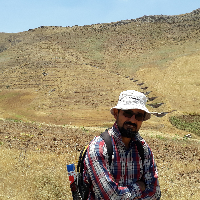Modeling of piping erosion in loess soils
Author(s):
Abstract:
Introduction
Piping erosion is one of the common water erosions usually occurs in soil with low infiltration and soluble minerals that finally changes landscape. Different factors control its occurrence and development. To predict piping occurrence/hazard through modeling, effective factors should be prioritized and considered as inputs of the model. The present study has performed through field survey for piping erosion across the Iky Aghzly watershed with an area of 105 ha lead to recording of about 102 pipes (≤1 pipe per ha). This study aims to detect the locations of piping erosion via the modeling of logistic regression.Methodology
In order to perform this research, all of the piping erosions in the study area were surveyed and their morphometric characteristics were recorded, and the sampling of the topmost 5 cm of soil was taken from inside and outside of the pipes. Then the principal comparison analysis (PCA) was used. To compare piping erosion in rangeland and cropland, X2 test and PCA were used. Additionally, the PCA and multivariate ANOVA were used to evaluate the main differences of the physicochemical soil properties of inner and outer sides of the pipes. Finally, the binary and multivariate logistic regression was applied to predict the existence or lack of piping's extension hazard, respectively.
Results
In this study, the danger of piping for humans and animals was calculated based on the depth of the pipes. Based on the results, a very high risk category (pipes with more than four meters depth) is mostly located in rangeland land use. Respectively, the amount of low risk, moderate risk, high risk and very high risk classes in the study area was 31, 29, 23 and 19. The results of comparison of piping erosion in rangeland and cropland showed that the shape of the hillslope, the shape of the piping and the soil texture are not dependent on the land use. There is also a significant relationship between the land use and direction of the piping extension at the significant level of 0.009. Based on the PCA, among few quantitative affective factors in the erosion of the piping, about 8 components were selected which contains almost 89 percent of the pipes in the study area. Comparison of the physicochemical properties of the soils showed that their means were significantly different in both inside and outside of the piping. To predict two state of the existence or lack of piping via binary logistic regression, with a quantitative and qualitative predictive parameter, a suitable model (coefficient of determination, r2, of 0.5) was calculated. Based on a multivariate logistic regression and considering the quantitative and qualitative predictive parameters, a suitable regression model with a coefficient of determination of 0.6 was found to model the risk of piping.
Discussion & Conclusions
According to the results of t-test for each component, it was determined that the land use of rangeland and cropland are significantly different only in piping coordinates. Since the amount of this component is higher in rangeland than that in cropland, this difference can be explained by the diameter and depth of the pipings in the rangeland, as well as the short proximity from the ridge. By comparing the physicochemical properties of the interior and exterior of pipings, it was found that the standard deviation of the data in the organic matter is very low, and the lowest difference is significant in the inside and outside of the piping. The results also showed that soil resistance, organic matter and bulk density decreased, as well as pH, EC, ESP, SAR, and porosity were increased. Based on binary logistic results, for the probability of a piping occurrence in a specific location to be determined, type of land use, soil resistance, geographic direction, shape of the hillslope, slope percentage, and pH is needed. In general, the factors affecting the formation of piping can be identified as biological activity and physical properties of soil such as texture (silty), low bulk density and high porosity with water penetration and severe surface runoff in the study area. The effective factors of the piping formation are land use, proximity from the waterway and soil resistance, and they are significant at 1% level. Using the logistic model in this study, the most important factors controlling piping were determined as the shape of the concave hillslope and topography of the pipe location as well as proximity from the waterways.
Keywords:
Language:
Persian
Published:
Environmental Erosion Researches, Volume:8 Issue: 4, 2019
Pages:
1 to 18
magiran.com/p1968437
دانلود و مطالعه متن این مقاله با یکی از روشهای زیر امکان پذیر است:
اشتراک شخصی
با عضویت و پرداخت آنلاین حق اشتراک یکساله به مبلغ 1,390,000ريال میتوانید 70 عنوان مطلب دانلود کنید!
اشتراک سازمانی
به کتابخانه دانشگاه یا محل کار خود پیشنهاد کنید تا اشتراک سازمانی این پایگاه را برای دسترسی نامحدود همه کاربران به متن مطالب تهیه نمایند!
توجه!
- حق عضویت دریافتی صرف حمایت از نشریات عضو و نگهداری، تکمیل و توسعه مگیران میشود.
- پرداخت حق اشتراک و دانلود مقالات اجازه بازنشر آن در سایر رسانههای چاپی و دیجیتال را به کاربر نمیدهد.
In order to view content subscription is required
Personal subscription
Subscribe magiran.com for 70 € euros via PayPal and download 70 articles during a year.
Organization subscription
Please contact us to subscribe your university or library for unlimited access!



